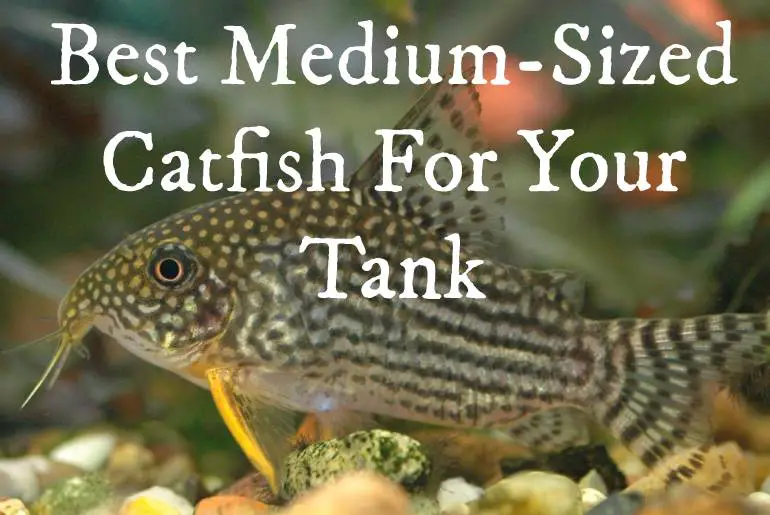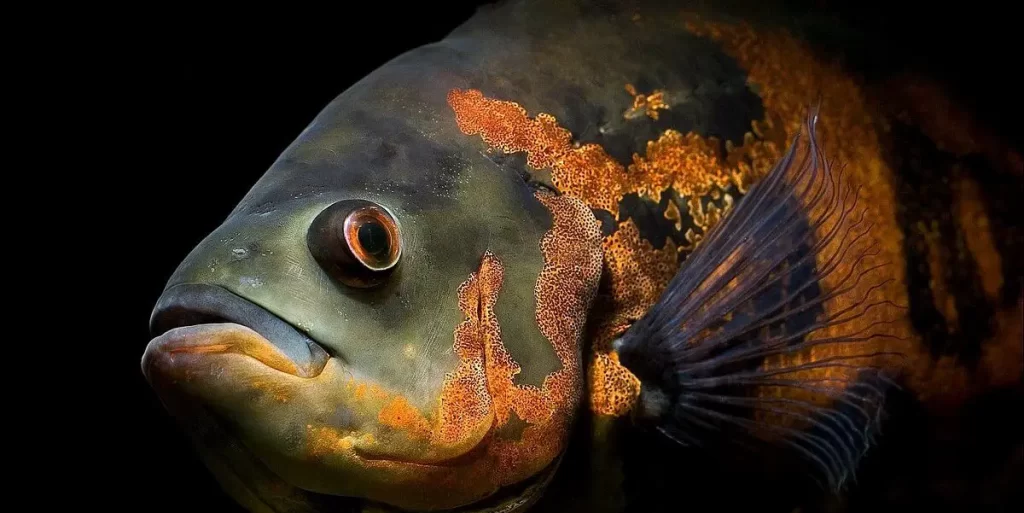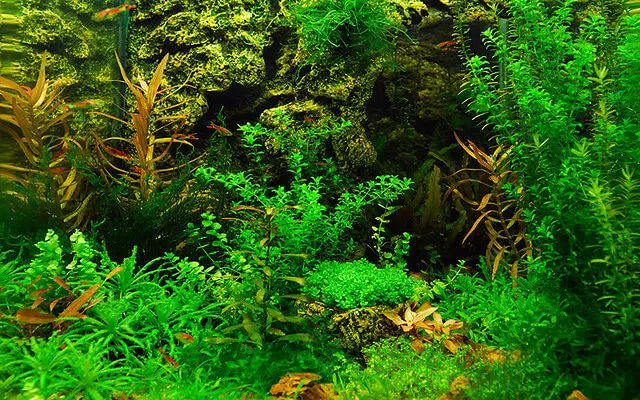People often contemplate catfish to be big and are only meant to be kept in bigger tanks. Well, there are not entirely wrong. Most of the catfish are so big that you cannot even imagine keeping them in a tank of less than 100-gallons capacity. I know this breaks the heart of many who really want to gain experience related to catfish. But don’t worry, there are few options from where you can choose some of the smaller ones. And the question arises: are there really medium-sized catfish that are best for the average-sized tank?
Glass Catfish, Pictus Catfish, Bristlenose Pleco, Clown Pleco, Striped Raphael Catfish, and Chinese Algae Eater are some of the best medium-sized catfish that will live happily in an average-sized tank. These catfish ranges from 4 inches to 10 inches and will adjust well in a tank that is less than 100 gallons in capacity.
But tank size is not the only thing that will determine how they live in a tank. You need to take care of water parameters and other tank conditions along with a balanced diet to make sure they grow up to their full potential.
I know I am creating another chaos with these jumbled words. So, to make it clear for you and help you find your suitable yet best medium-sized catfish, I have written an entire article below.
Let’s dive in!
Best Medium-Sized Catfish
When we think about or even talk about catfish, we often end up imagining Common Pleco. Common Pleco is way bigger and is one of the fish you need to avoid for smaller tanks.
You might like to read an article on 5 Best Dwarf Catfish For Smaller Nano Tank Setup
I have often imagined keeping common Pleco in the home aquarium. But the idea of raising a whole grown fish that will be 2 feet long in no time gives me chills.
I have written an entire article dedicated to that How Big Can A Plecostomus Get? Plecostomus Size
I can understand what you are going through and why you stumble on this article. There are very few medium-sized catfish that you can go for.
Everyone wants the best for their tank and no one will ever compromise when they make up their mind for catfish.
If you are already thinking about keeping a catfish why settle for smaller ones, right? You will need an average-sized tank anyway so why go for smaller catfish when there are a little bigger options.
Here are some of the best yet medium-sized catfish that you can keep in the tank. You will absolutely love these and I guarantee you will not be disappointed if you raise them right.
Glass Catfish
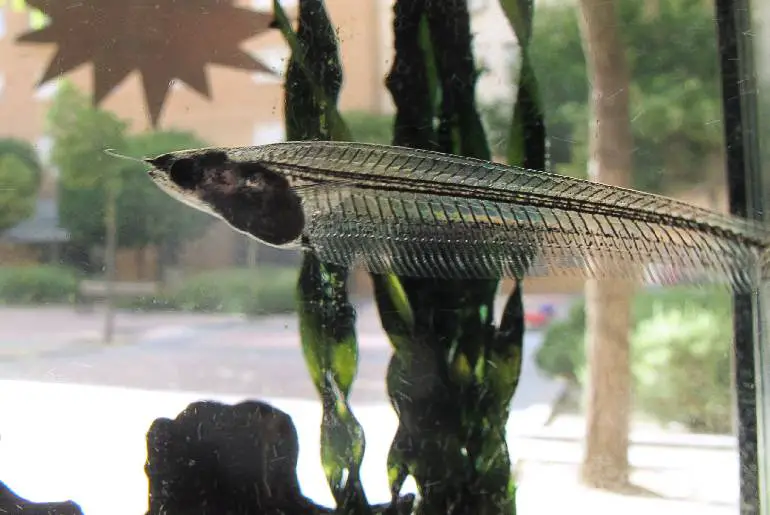
| Temperature | 75 to 80°F |
| Hardness | KH 8 to 12 |
| pH | 6.5 to 7.0 |
| Size | 5 Inches |
| Care Level | Moderate |
| Lifespan | 7 to 8 Years |
| Minimum Tank Size | 30 Gallons |
Who doesn’t like to spice up the ecosystem of an aquarium with a unique and surprising factor? And what is better than adding a transparent fish in the tank which is so clear to even find if not looked for them?
Not that they are invisible or anything, but you can imagine how they will look when they have a crystal clear body. Hence their name glass catfish explains it all for you.
This one is the first on my list because of their unique body and yet will happily reside in a 30 gallons tank.
Are you into horror movies? I would love to have a spooky thing that gets cuter every time. What is better than a Ghost catfish or Phantom catfish?
You can clearly see the inner skeleton system as well as the organs of the fish if you look clearly. I often thought that this fish will be great during the Halloween season to spook people around.
If you have a bigger tank then you can keep nearly 5 to 6 catfish in the tank. This will unquestionably feel like 5 to 6 skeletons swimming in the tank.
Also, swimming in the tank reminded me of the best trait of this typical catfish. As you might know, most catfish will stay at the bottom of the tank scavenging through the substrate.
However, it is different in the case of glass catfish. They will swim happily in the tank and you will see them mostly on the mid-section of the tank.
Also, your glass catfish has barbells from their face and out of their nose.
Pictus Catfish
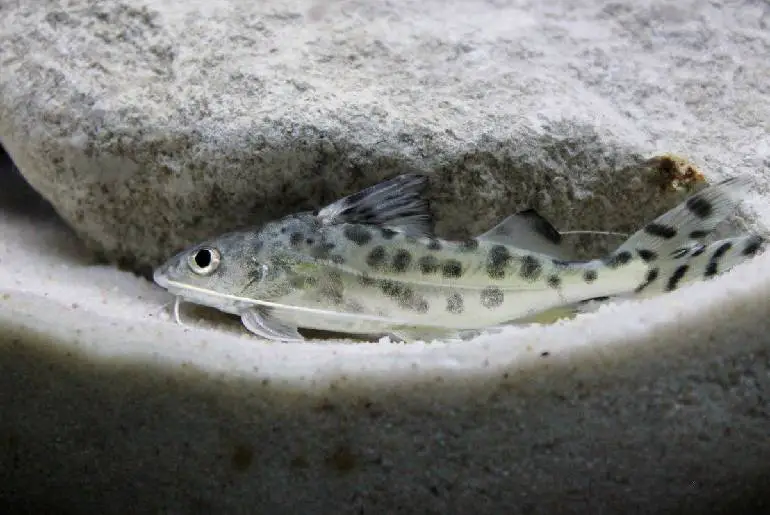
| Temperature | 75 to 81°F |
| Hardness | 8 to 12 KH |
| pH | 7.0 to 7.5 |
| Size | Up To 5 inches |
| Care Level | Easy |
| Lifespan | 8 years and more |
| Minimum Tank Size | 55 gallons |
Let’s talk about an angel in this very moment, not an “Angel with wings” angel but the ones with fins. Of course, it is none other than our dear Angel cat which is also known as Pictus cat.
You can never make a mistake in recognizing this wonderful and entertaining catfish. I know this one might give a hard time for the beginners but they can be great ones to raise if you know what you are doing.
I have personally loved the way Pictus catfish is adventurous and exciting to raise. You cannot miss this active and fast fish in the tank. It is one of the best treasures for you to keep.
Thanks to their average size, they will live happily in the tank with 55 gallons capacity. However, they will do great in the 100-gallon tank.
It is not a compulsion to keep them in that tank and they will stay with no complaint in 55 gallons tank as well.
Also, you will have no problem finding them in the tank. The black dots highlighted in the white body of the fast-moving fish are quite hard to miss.
And of course, the most distinguishing factor of any catfish from other catfish, their whiskers. The whiskers even grow back if damaged during their daily rampage.
You have to, however, be careful while transporting them from one place to another. These fish can be quite fragile but are a great companion.
Similarly, you have to take care of the lighting to make sure it is dim enough for the nocturnal being like Pictus catfish.
Bristlenose Pleco

| Temperature | 60 to 80 degrees Fahrenheit |
| Hardness | 8 to 12 KH |
| pH | 6.5 to 7.5 |
| Size | Up to 5 inches |
| Care Level | Easy |
| Lifespan | 5 years and more |
| Minimum Tank Size | 30 gallons |
If you are looking for a catfish that will live happily in the community tank, then Bristlenose Plecos are your go-to catfish.
They are extremely peaceful and are a great addition to the tank that is maintained by beginners.
Compared to any other catfish, this one can be quite low maintenance and ask very little in the tank. But you have to remember that these catfish grow quite fast and attain the same size as parents within the interval of just 6 months.
So, just because they are smaller in beginning doesn’t give you a window to keep them in a tank smaller than 30 gallons.
Do not risk keeping them in a small tank with tank mates too many to handle. They will often get suffocated due to overcrowding and their fast-growing body.
You have to get a tank with a large bottom area as these catfish spend most of their time at the bottom of the tank.
It is no big deal when it comes to feeding or taking care of Bristlenose Pleco. To be honest, this one might be the easiest catfish you can raise in the tank.
However, there is one thing that will be life-threatening for your fish if not done right. They live in highly oxygenated water in the wild. Hence they will ask for the same thing to happen in the aquarium as well.
Bristlenose Pleco also likes to hide during the daytime. So, make sure there are various shaded areas and decorations for this nocturnal fish to hide in.
Clown Pleco
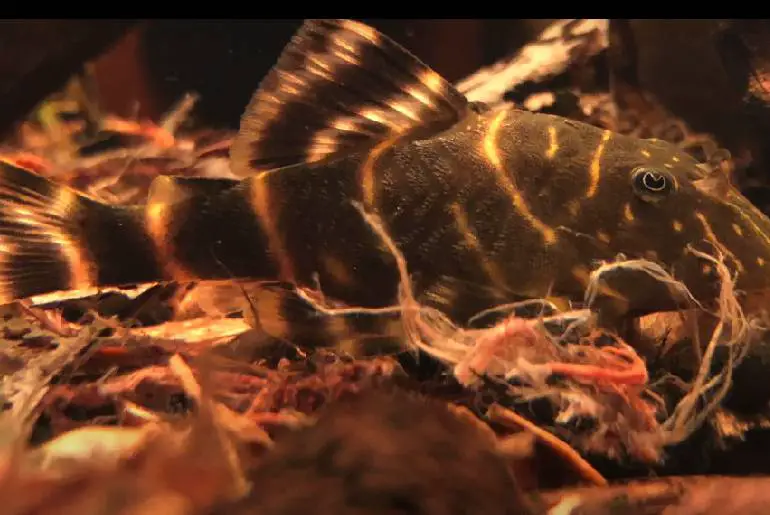
| Temperature | 73°F to 82°F |
| Hardness | 10 dGH |
| pH | 6.8 to 7.6 |
| Size | 3.5 inches |
| Care Level | Moderate |
| Lifespan | 10 to 12 years |
| Minimum Tank Size | 20 gallons |
Now it is time for the clown to make an entry. I truly have a phobia related to clowns so I would not joke about this catfish.
They are named clowns because of their patterns in the body. But trust me, it doesn’t look too bright or outgoing just a simple hint of beauty.
The vibrancy and patterns might vary between clown Plecos as well. This happens because of the genetic factors as well as the health status of your fish.
If you see your clown Pleco losing the brightness of their color and vibrancy, then look for other symptoms of sickness or stress too. These clown Plecos lose color when they are stressed or sick.
If you take care of them properly, they will be a great addition to your tank. They will definitely add a new shade of the rainbow in the sky of the aquarium.
And of course, they are hardy. Hence the care they ask for is quite null and these are quite low-maintenance fish.
They will even leave happily among other fish and are quite okay in living in unclear water too. Their natural habitat is dim-lit so they will need the same type of treatment in the tank too.
They are bottom-feeders so remember to get the food that will right to the bottom of the tank. You will fall in love with these beautiful scavengers.
Striped Raphael Catfish
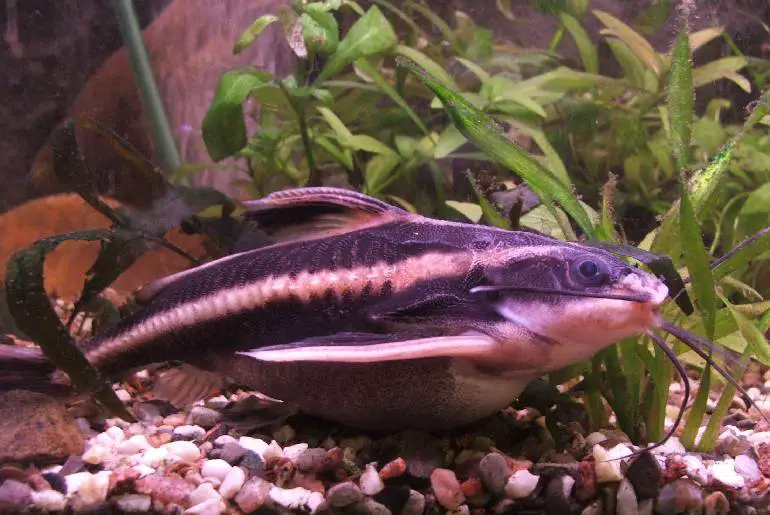
| Temperature | 75°F to 80°F |
| Hardness | 4 to 20 dKH |
| pH | 6.0 to 8.0 |
| Size | 6 inches |
| Care Level | Easy |
| Lifespan | 10 years |
| Minimum Tank Size | 50 gallons |
Moving on to our next catfish from the list of best medium-sized catfish, we have Striped Raphael Catfish.
I might have kept them down in the list but do not overthink and conclude that these fish are less good. They are equally loved and chosen by aquarists as they would choose any other one from this list.
These striped catfish are wonderfully unique and have their own distinguishing which makes them a better companion for your home aquarium.
There are various reports that have shown these catfish can reach up to 7 to 9 inches in the tank. And they are known to grow up to 17 inches in the wild.
So, while you are purchasing and preparing a tank for them, remember the way they can grow and the size they can attain.
Here is an article on How To Set A 50-Gallon Fish Tank?
These torpedo shape catfish have white stripes that run through their black or brown body. Now, you can understand why these catfish are called the striped ones.
While these fish are known for their toughness and hardy nature, they are little sensitive towards the water quality.
You need to maintain the constant water conditions and do not let that fluctuate often. These striped Raphael catfish will react quite differently when it comes to water quality and consistency.
Chinese Algae Eater
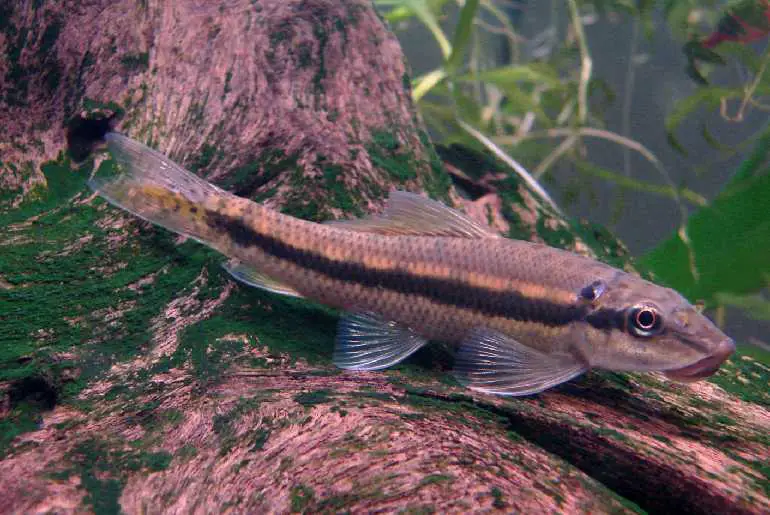
| Temperature | 75 to 80 degrees Fahrenheit |
| Hardness | 8 to 10 KH |
| pH | 5.8 to 8.0 |
| Size | 5 inches |
| Care Level | Easy |
| Lifespan | 10 years |
| Minimum Tank Size | 50 gallons |
Last but not the least, we have a Chinese algae eater in our list of best medium-sized catfish and this list cannot get any better.
We can never talk about catfish and leave behind an algae eater, can we? Chinese Algae eaters are full of wonder if we start counting it.
They will happily stay in the bottom of the tank scavenging the substrate. These catfish will not even make any fuss in the tank and will be ideal catfish for beginners who want to keep a medium-sized fish.
But you have to make sure the bottom of the tank is safe for them. If there are any sharp decorations down at the bottom of the tank, this will injure your Chinese algae eater.
So, make sure there are smooth decorations that are considered fish-proof. Also, you need to add smooth flat rocks where algae can grow.
Learn more about Guide to Different Types of Aquarium Substrates | Choose the Best Type
People often try to get rid of algae naturally but here I am suggesting you let it grow. However, the algae eater will no doubt need a few algae here and there to feel at home.
Don’t worry, you will not have to deal with these algae as your infamous Chinese algae eater will munch it off while scavenging and rampaging the bottom of the tank.
Thanks to their sucker mouth, these Chinese algae eaters can make you sweat by jumping out of the tank. Hence to keep these escape artists within in tank you need to make sure your aquarium lid is well-put.
Here is an article on Why Do I Need A Lid For My Fish Tank? Here Are My 5 Reasons
Things You Need For Your Medium-Sized Catfish In The Tank
We often stumble through the things we need to do for our fish. Sometimes they get so fussy over the small thing and sometimes they will act so rationally you don’t even understand what’s wrong with them.
Here is the thing: you can never be too careful when it comes to taking care of a fish even if it is a hardy one.
I often wondered if my aquarium would function properly if I remove all the extra gadgets from the tank. And hence, I remember the nightmare that creeps through the darkness and destroys the well-maintained ecosystem.
I have also written an article on Fish Tank Setup For Beginners | Aquarium Setup – Fishkeeping Guide
When you take catfish from, their natural habitat to place them in an aquarium, you need to make sure the aquarium mimics their natural habitat.
You need to give them optimum temperature with ideal water quality along with a qualitative balanced diet.
You might like to know more about Fish Food 101: A Beginner’s Guide On How To Feed Aquarium Fish
Here are the things you need to have in the tank for your catfish to stay happy:
- A high branded aquarium Heater
- An aquarium Filter
- Perform 25% of water change once every week or two
- Sinking pellets or flake foods
- Brine shrimp, Mysis shrimp, and bloodworms (live or frozen)
- Plenty of hiding places
- Check water quality at least once a week
Here is an article on The Easiest Way to Clean and Maintain Aquarium
Frequently Asked Questions
I know the questions related to these best medium-sized catfish don’t end here. So, I have tried to answer some of the FAQs that people often ask. I hope this will help you and make fishkeeping a little easier for you.
Are Pictus Catfish Aggressive?
The definition of aggression varies according to the type of fish you are keeping. But first, you need to know the true nature of any fish: Bigger fish will eat smaller fish if the smaller ones fit in their mouth.
So, you cannot blame and put a tag of aggression on Pictus catfish just because they ate up your smaller fish in the tank.
These Pictus catfish are quite peaceful, non-aggressive, and non-territorial. They will not act absurdly when there is another fish in the tank.
However, if the fish present in the tank is small ones like neon tetra, then they will most definitely eat them up.
Pictus catfish is a peaceful one from the lot and yet it cannot leave behind its predatory nature. And you cannot blame them for their true nature.
You might like to read an article on How Big Do Pictus Catfish Grow In Size?
Do Clown Plecos Produce A Lot Of Waste?
Clown Plecos can be the real deal when it comes to their feeding habit and special dietary needs. Thanks to their eating habits, their excretion is also something that needs to be talked about immediately.
So, firstly let me answer you clearly. Yes, Clown Plecos produce a lot of waste in the aquarium. They tend to eat more compared to other smaller fish and the waste materials are also quite a lot.
You might like to read more about Why Do Fish Tanks Get Dirty So Fast – How To Clean And Maintain Tanks
You need to make sure you have a good filtration system and need to clear this waste immediately. Clown Plecos add a new duty to your to-do list for daily endeavors.
Siphoning the substrate regularly is the must and most important part of cleaning the tank.
If you want to maintain the water quality and keep water chemistry in check, you need to do this without a miss.
Here is an article you might like to read The Easiest Way to Clean and Maintain Aquarium
Conclusion
In conclusion, it can be truly tiring to find a suitable fish match for the tank you have at your home. And when it comes to medium-sized catfish, the options narrow down to quite a few yet best ones. Sometimes, the deal with catfish is unrealistically fascinating yet confusing. As even with the little options, people often stumble around to find the right one. I don’t blame you for that and it is okay to question your choices time and often. But remember to maintain the tank size and other tank conditions for the catfish you go for according to the parameters they ask for.
These fish might not be quite demanding but they will certainly appreciate your genuine effort. If you do what they ask for, you will end up with a healthy and full-grown medium-sized catfish.
If you still have questions regarding this article, drop a comment below and I will try to answer it back quickly for you.
Good Luck!!!
Happy Fishkeeping!!!

